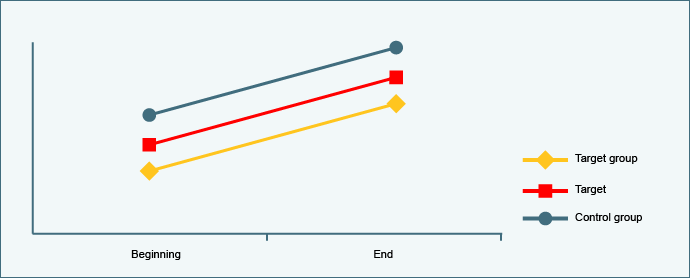
Characteristics
The development of the target group is linked to that of the control group and the objectives.
Example
50% of the rural population in Region x lives with 15 minutes’ walk of clean drinking water; at the beginning of the project it was only 30%. The improvement of 20 percentage points is just as good as in the control group in Region y, whose access to drinking water improved over the same period from 50% to 70% of the population. The target of 60% could not be achieved.
| Advantages | Disadvantages |
| It can be shown what changes the intervention has brought to the target group | Data collection is difficult and requires at least 4 measurements. |
| It can be recorded whether the objectives have been achieved. | The approach is methodologically demanding. |
| The approach is methodologically sound. | No assertions can be made about the project’s sustainability. |
| It is possible to attribute the effect to the intervention. |
Suitability
This model is suitable for learning, steering and legitimation. It is used for agreed objectives and in particular applied when effects must be clearly demonstrated and there are no ethical reservations about comparisons with control groups. Suitable control groups must be able to be defined or constituted. If the initial situation of the control group is not identical with that of the target group, the difference between the target and the control group must be established at the beginning and at the end of the project. Assertions about the effect depend in this case on whether the difference has increased or decreased. This method is known as “difference in difference”.

